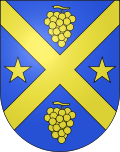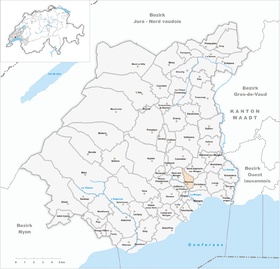Monnaz
| Monnaz | ||
|---|---|---|
| State : |
|
|
| Canton : |
|
|
| District : | Morges | |
| Municipality : | Echichens | |
| Postal code : | 1125 | |
| Coordinates : | 526343 / 153 457 | |
| Height : | 485 m above sea level M. | |
| Area : | 1.61 km² | |
| Residents: | 372 (December 31, 2010) | |
| Population density : | 231 inhabitants per km² | |
| map | ||
|
|
||
Monnaz is a place and a former municipality in the Morges district of the canton of Vaud in Switzerland . On July 1, 2011 Monnaz merged with Colombier and Saint-Saphorin-sur-Morges to form the municipality of Echichens .
geography
Monnaz lies at 485 m above sea level. M. , two and a half kilometers northwest of the district capital Morges (beeline). The village extends on the southwestern edge of a plateau above the valley of the Morges , opposite Vufflens-le-Château, in the Waadtländer Mittelland , in a panoramic position around 100 m above the lake level of Lake Geneva .
The area of the municipality of 2.3 km² covers a section of the Vaud Central Plateau north of Lake Geneva. The area is bordered in the south-west by the approximately 60 m deep valley of the Morges, the south-east border forms its left side stream Baillon . To the north, the municipality extends over the gently undulating plateau of the Central Plateau and reaches at La Solitude at 530 m above sea level. M. the highest point of Monnaz. In 1997, 8% of the municipal area was accounted for by settlements, 16% for forests and woodlands and 76% for agriculture.
Several individual farms belong to Monnaz. Before the merger, the neighboring municipalities of Monnaz were Vufflens-le-Château , Vaux-sur-Morges , Colombier , Saint-Saphorin-sur-Morges and Echichens .
population
With 372 inhabitants (as of December 31, 2010) Monnaz was one of the small communities in the canton of Vaud. 87.5% of the residents are French-speaking, 7.5% German-speaking and 1.4% Italian-speaking (as of 2000). The population of Monnaz was 139 in 1900. Since 1970 (128 inhabitants) there has been a rapid increase in population, with the number of inhabitants almost tripling within 30 years.
economy
Until the second half of the 20th century, Monnaz was predominantly an agricultural village. Even today, agriculture has an important role in the income structure of the population. On the slope above the Morges there are some small wine-growing areas (8 hectares in total). Only a few jobs are available in local small businesses and in the service sector. In the last few decades the village has developed into a residential community thanks to its attractive location. Many workers are therefore commuters who work mainly in Morges and Lausanne.
traffic
The municipality is well developed in terms of transport, although it is located off the main thoroughfares on a cantonal road from Morges to Clarmont . The Morges-Ouest motorway junction on the A1 (Geneva-Lausanne) opened in 1964 is around 3 km from the town. Monnaz is connected to the public transport network through a Postbus course that runs from Morges to Apples .
history
The first documentary mention of the place took place in 1213 under the names Mona and Monna . In 1221 the name Muna appeared and in 1453 the current place name. It probably goes back to the Latin personal name Monnus . Since the Middle Ages, the small lordship of Monnaz has been under the lords of Montricher . With the conquest of Vaud by Bern in 1536, Monnaz came under the administration of the Bailiwick of Morges . After the collapse of the Ancien Régime , the village belonged to the canton of Léman from 1798 to 1803 during the Helvetic Republic, which then became part of the canton of Vaud when the mediation constitution came into force . In 1798 it was assigned to the Morges district.
Attractions
The church of Monnaz, mentioned in the 12th century, underwent major renovations in 1680 and 1878. The core of the castle with a square stair tower dates from the 14th century, but it was fundamentally redesigned in the 18th and 19th centuries. The town center with its houses from the 18th and 19th centuries has retained its appearance.
Web links
- The history of Monnaz on the Echiens municipality website
- François Béboux: Monnaz. In: Historical Lexicon of Switzerland .
- Aerial photography
Individual evidence
- ^ La nouvelle commune d'Echichens , French , accessed September 30, 2012


